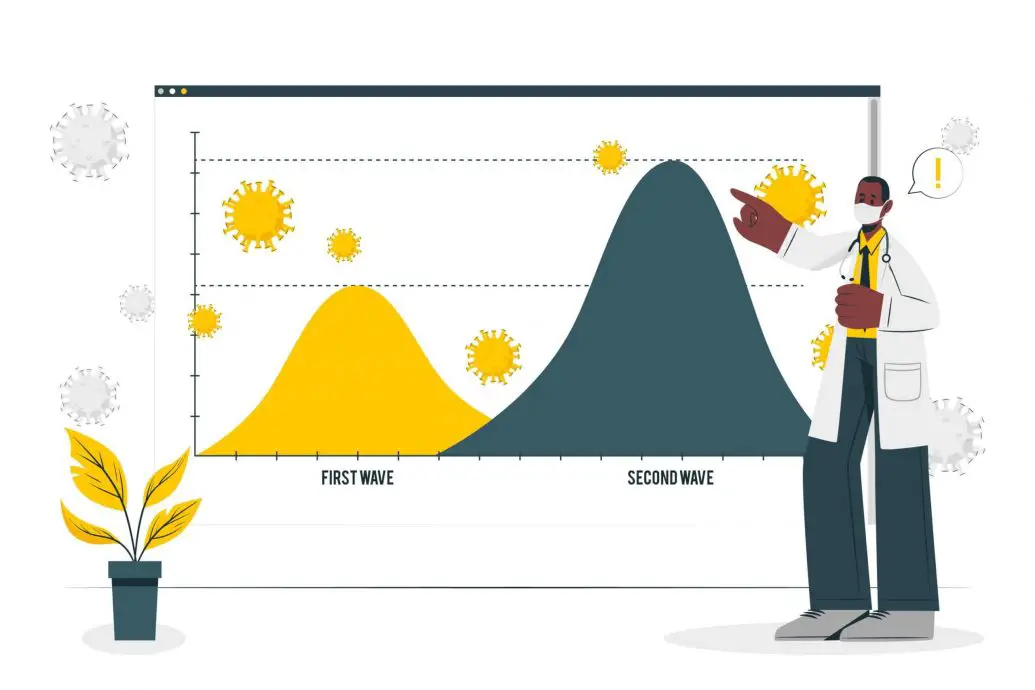Introduction: Covid-19 – India’s Second Wave – When will it peak?
Covid-19 – India’s Second Wave – When will it peak? Predictive analysis about India’s second wave with open source data. The following numbers have been calculated using mathematical models with open source data. The prediction is dark and scary.
Table of contents
Wash your hands.
Wear a mask.
Maintain social distancing.
Get vaccinated.
Numbers: Covid-19 – India’s Second Wave – When will it peak?
Here are the numbers based on the predictive analysis –
-
Peak: Cases per day to reach between: 350,000 to 500,000
-
Cases to peak by: May 15th to 30th, 2021.
-
Peak to last: 20 – 30 days.
-
Cases will come down slowly and not as rapidly as they grew.
-
A regression phase after the peak will last for 30-40 days.
-
India is in a race against time to get vaccinated.
-
Variants, raw material shortages are going to throw a wrench.
We need to discuss vaccinations, which are critical to stem the spread of the virus. Vaccinations are not the be all solution, COVID-19 is here to stay with us. You still need to practice social distancing, wear masks, wash hands regularly even after you are vaccinated. This is going to be an endemic, this is a game of time, we need to be patient till the virus loses its potency to survive within the host. We need to be mentally prepared this virus will stay on till 2025-2030 at the minimum.
We need to have a global approach to vaccinations. We cannot think about vaccinations on a country by country basis. We need at least 30-45 different vaccinations that can fill the diverse void by covid variants. We as a human race need to plan for 32-40 Billion vaccination doses. Why? Well, variants and vaccine adjustments mean we would need multiple doses to out pace Covid.
Also Read: The role of artificial intelligence in vaccine distribution.
The role of artificial intelligence in vaccine distribution will be very critical in vaccinating the global population against COVID-19. Vaccine distribution is one of the biggest logistical challenges humanity has faced so far and I think AI can be leveraged to help us with the equitable distribution of the vaccine.
In the United States, as of now the rollout of the vaccine has been painfully slow with a lot of logistical issues from distribution to inoculations. Worldwide, the progress is even more sluggish, with some countries yet to start the journey of inoculations.
The role of artificial intelligence in vaccine distribution involves the following challenges that AI can help with provided we have quality and accurate data.
Demand forecasting.
Distribution network.
Supply chain management.
Inoculation priorities.
Waste reduction.
Adverse event surveillance.
Accurately forecasting demand for the vaccine is particularly important for vaccine distribution and this exercise helps in the distribution network that these vaccines need to be on for an efficient rollout. We would like the right amount of doses of vaccines to reach the right population that critically needs it before than anyone else.
Also Read: How can Artificial Intelligence help with the Coronavirus (Covid-19) vaccine search?
Demand forecasting can be done by identifying the right parameters for the set of the population that is most vulnerable, this means collating anonymous data of co-morbid conditions that impact the severity of the disease. Once we have this information we can equitably distribute the doses across the globe and save more lives. This will help the distribution be fair and most effective. Running AI-based algorithms to identify vulnerable patients and the critical mass of the patients is very important for effective vaccine distribution. The role of artificial intelligence in vaccine distribution cannot be understated, especially if we want the vaccine to be distributed in an effective and efficient manner. We could have been better prepared for vaccine distribution if we had better demand forecasting across the globe for vaccine distribution. We should start collecting anonymous data for future pandemics so we are better prepared.
Conclusion
Some technologists have lamented that the role of artificial intelligence in vaccine distribution hasn’t been a big help during the pandemic. While some A.I. software helped sound early warnings that a worrisome new respiratory virus seemed to be circulating in Wuhan, China, the technology certainly didn’t help prevent the pandemic. And its impact on epidemiological modeling and policymaking has been minimal. This is mostly because of a lack of an accurate and good data set. This should be a lesson for us and we should start building the data sets that can help us in future pandemics.
In helping to ensure that vaccines are distributed quickly and safely, the role of artificial intelligence in vaccine distribution may yet prove its worth.
